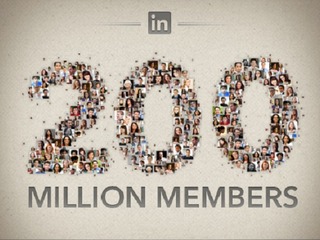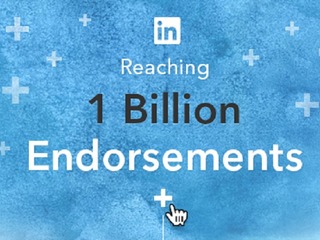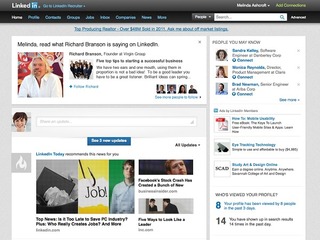MyFitnessPal launches support tools for patients on GLP-1 meds
The tools include content such as educational videos, recipes, and daily nutrition tips
Read more...
Facebook was not the first social network by any means. But I think that it can be successfully argued that it was the one that brought the idea to the mainstream (no offense to Friendster and MySpace).
Of course, when you become a Goliath, there will be a slew of Davids out there, who are just waiting with their slingshots to fling a rock and who will watch with glee while you hit the ground. And for a long time I think it was assumed that Twitter would be the one to do it to Facebook. Or at least that was the hype.
But could it actually turn out to be LinkedIn that emerges at the true successor to Facebook? There are real reasons to say, "No way!" to that the theory. But the numbers might just say otherwise.
A tale of two networks
In some ways, Facebook and LinkedIn, while both sharing the social network designation, cannot be further apart in their approaches.
When I think of Facebook, I see it almost as the only all-around network; one that can be used for basically any purpose: personal connections, work connections (though these are typically limited, and that is what probably led to the rise of LinkedIn) or whatever else a person wants to use it for. I know people who needed to look for an apartment, so they signed up to look at listings, for example. There are a myriad of things that Facebook can be used for.
LinkedIn, on the other hand, is a niche network; one with a very specific purpose: collect and track contact for your professional life. And it really can't be used for much else.
But, while being a niche network would seem, at first glance, to be limiting, it can actually be seen as both a benefit and detriment to its long-term sustainability of a network.
First, the benefit.
Until recently, users did not generally visit LinkedIn to just see what was new or what was happening. The information that is posted does not typically change (if you're starting a new job every few months then you might have a problem!) so I'd look at a few profiles and then click it off.
LinkedIn was obviously well aware of this issue, since retention rates are key to advertisers, and advertisers are key to making money. So the site has gone about changing that in a big way by introducing a multitude of products, starting last year.
For example, LinkedIn introduced "influencers" this past October, to make the service a professional publishing platform. The most popular influencer is Richard Branson, with over 1.3 million followers. There have been posts with over one million views. The success of influencers helped drive eight times more traffic to LinkedIn Today content in the fourth quarter of last year.
The network also added endorsements, a way for users on LinkedIn to recommend skills that their connections have, from knowing C++, knowing editing software, to creative writing or even fitness. There were over a billion endoresments given out in just six months.
LinkedIn added new search capabilities the company, which debuted in March; LinkedIn Contacts, which integrate email and calendars; and the addition of rich media last month.
And this has helped LinkedIn to become, not just a place to link up with professional contacts, but the place to go for a complete professional network. It has become a site where people go to place to build up contacts over time, and, to many professionals, it has become an incredibly valuable resource.
Let's put it this way: if you cancel your Facebook account, then what do you really lose? You might be out of the loop on some things, but generally it won't affect your life too much. LinkedIn, though, has become so vital to so many professionals that they almost can't afford to not be on it. It is much harder to leave a network when you are so dependant on it.
LinkedIn also does not have to worry about always being the "cool kid" on the block. While 80% of LinkedIn's members are 35 years or older, Facebook wins when it comes to young people, leading LinkedIn 26% to 19% in monthly visitors aged 18 to 34.
But that could wind up biting Facebook in the long run. The younger crowds are notoriously fickle, and a recent study by Piper Jaffray found that interest in Facebook among teenagers is declining, with its ranking as the most important social media site dropping 10% in a year.
Teenagers, they found, want to find their own social networks. I doubt that professionals who use LinkedIn have the same desire to assert their independence. In fact, given their more advanced age, they are probably happy to settle in with the same network that they feel comfortable with (while 35 isn't old in the real world, in Internet years they might as well already be in Depends).
But here's the downside to being a niche network:
The very definition of niche is that you have limited appeal. And that will, ultimately, keep LinkedIn from reaching the same heights that Facebook has in terms of user numbers.
LinkedIn recently surpassed 200 million members; in September Facebook had one billion people using it a month. And that is because Facebook can be used by elementary school kids, high school kids, and retirees; all groups that would have little to no use for the LinkedIn network.
Since LinkedIn is only used for work and professional connections, and it appeals only to those with those kinds of jobs, it is ultimately going to be limited in how far it will be able to grow. If you do not have the career that requires networking, or do not have a job at all, the appeal of LinkedIn is limited.
The numbers
But, while LinkedIn will never have the number of users that Facebook has, the two recent earnings reports show two networks going in opposite directions.
In its last earnings report, Facebook posted revenue of $1.46 billion for the quarter, higher than Wall Street's estimates of $1.44 billion, and up 38% from $1.06 billion in the first quarter of 2012.
But, while the company's revenue increased by more than 30% year-to-year for the fourth time in a row, having gone up 40% in the last three months of 2012, and up 32% in both the second and third quarter of last year, this was the first time that Facebook's revenue growth has slowed down from quarter to quarter.
Meanwhile, the company's user growth has been decreasing every quarter. It's MAUs were up 29% year-to-year in Q2 2012, then dipped to 26% in Q3, 25% in Q4 and now its down to 23% year-to-year growth. This may be because, well, Facebook has half the Internet population using it every month already. There is only so much it can grow!
LinkedIn, meanwhile, has had three fantastic quarters in a row, absolutely trouncing Wall Street expectations.
In the third quarter of 2012, LinkedIn posted non-GAAP earnings per share of 22 cents a share and $252 million in revenue. The social network was expected to post earnings of 11 cents per share and $243.9 million in revenue.
Then, in the fourth quarter, the company saw non-GAAP earnings per share of 35 cents on revenue of $303.6 million, well above the consensus estimates compiled by Thomson Reuters of 19 cents a share on revenue of $279.5 million.
And, in the first quarter of this year, non-GAAP earnings per share were 45 cents on revenue of $324.7 million. Analysts had been projecting EPS of 31 cents a share on revenue of $317.1 million.
Growth for the company did slow this past quarter; after going up 81% year-to-year in Q3 and Q4, the first quarter of 2013 saw revenue rise 72%. But the company is still taking in revenue far faster than Wall Street has been expecting.
The company also doubled its userbase in two years. The network reached the 100 million mark in March 2011, just ahead of its IPO, and then hit 200 million in January 2013. LinkedIn have a ceiling, but it still has a good amount of growth to do before it gets there.
Conclusion
While LinkedIn will never have a billion members like Facebook does, it has a good chance of being the last one standing. The more people who join and find that it is the place to go for their professional connections, the less likely those people are going to drop it.
And, considering who LinkedIn's audience is, there seems little risk that another, flashier site will be able to come along and steal those customers away.
Facebook, while it has the numbers on its side, may just prove to be less vital than LinkedIn, and its audience more fickle. It will keep having to evolve and change at a much faster rate, if it wants to retain, and grow, its current userbase.
(Image source: https://tickledbylife.com)
The tools include content such as educational videos, recipes, and daily nutrition tips
Read more...Advances in technology, like in vitro and microfluidics, have helped advance research
Read more...Robots are taking over the heavy lifting work inside warehouses
Read more...



